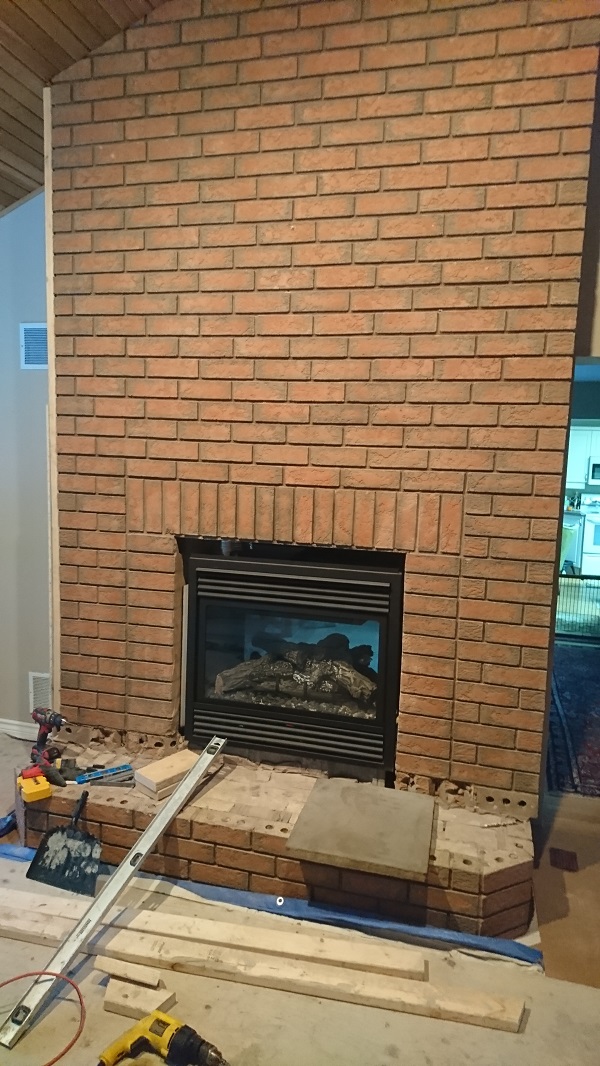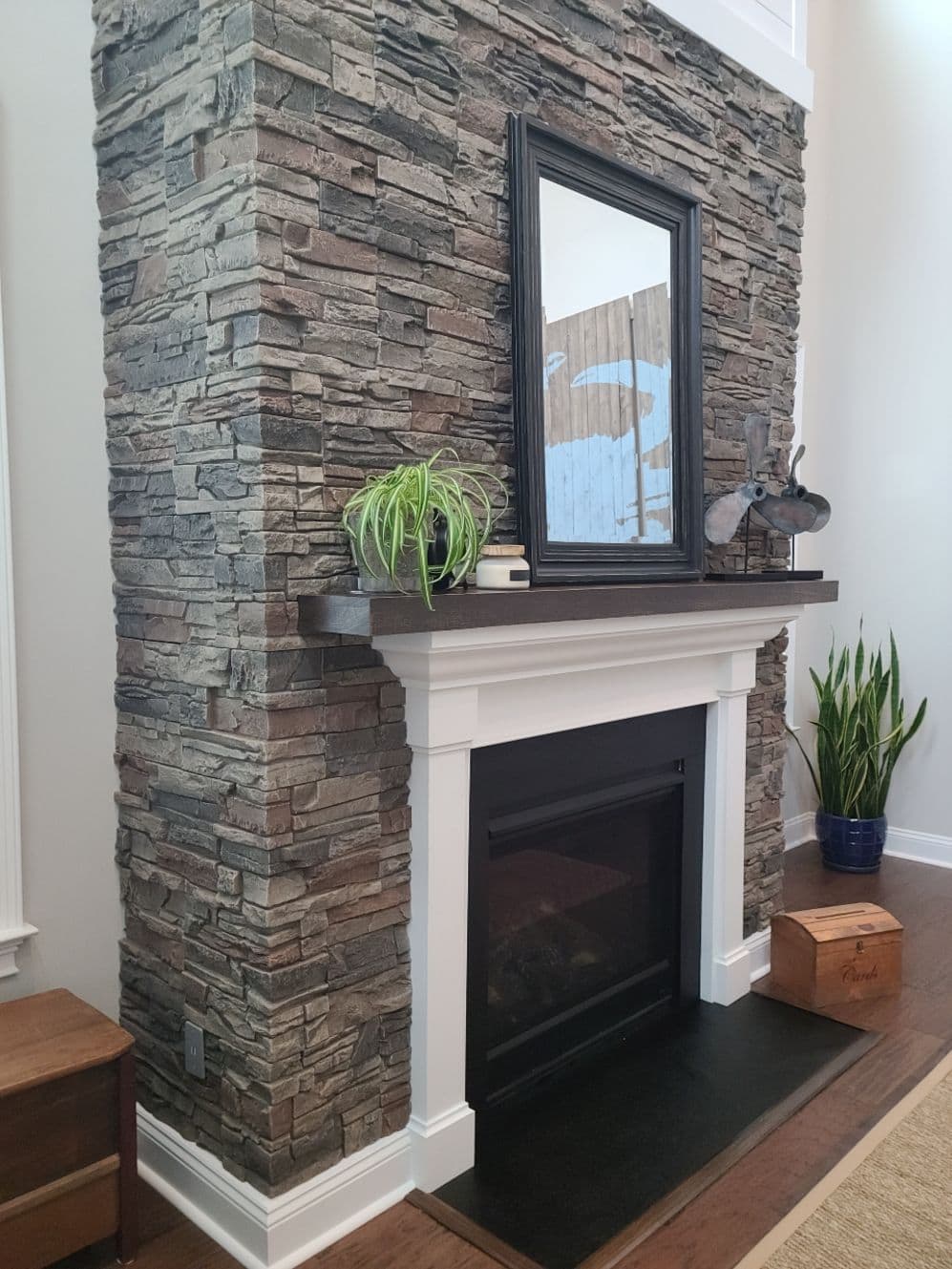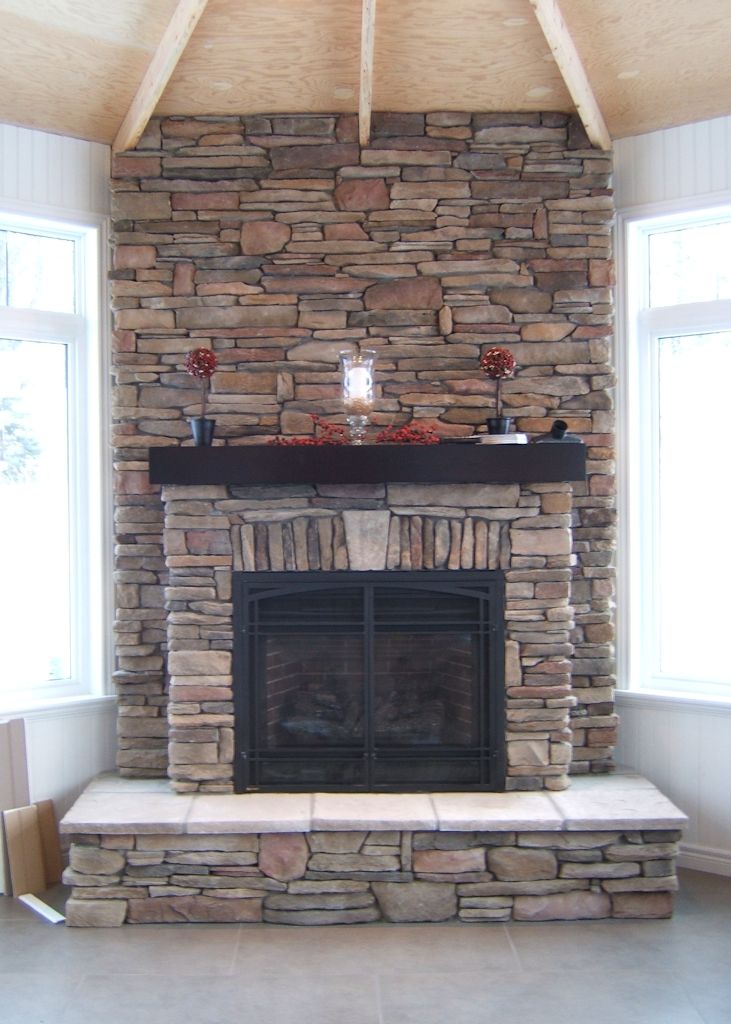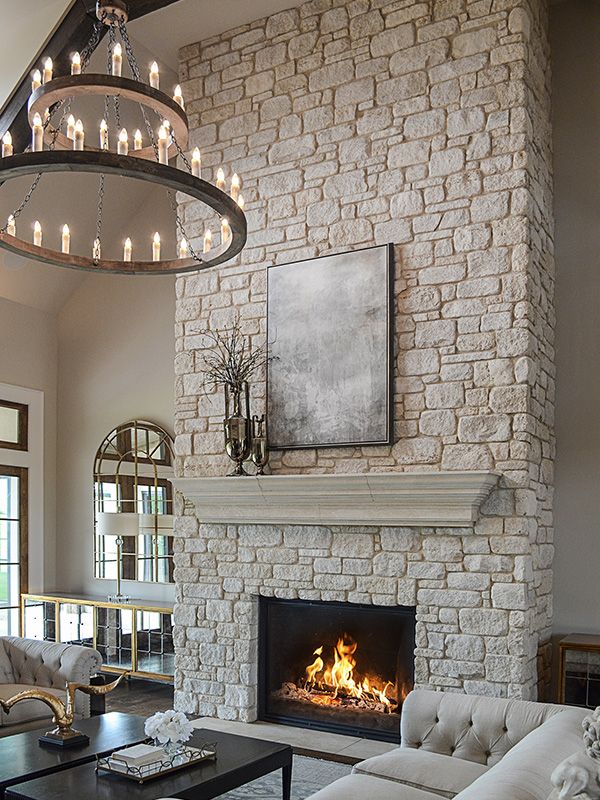Stone fireplace veneer offers a timeless and elegant upgrade to brick fireplaces. It combines the beauty of natural stone with the practicality and affordability of manufactured veneer, creating a stunning focal point in any room. Today we will discuss the benefits, preparation, installation, maintenance, design considerations, and common mistakes related to stone fireplace veneer over brick.

Understanding Stone Fireplace Veneer
Benefits of Stone Veneer
Stone veneer brings the natural beauty of stone into your home without the cost and weight of full stone construction. It’s available in a wide range of colors, shapes, and textures, allowing for customization to fit any design aesthetic. Stone veneer is also relatively lightweight and easier to install compared to natural stone, making it a popular choice for DIY enthusiasts and professional remodelers alike.
Types of Stone Veneer
There are two primary types of stone veneer: natural stone veneer and manufactured stone veneer. Natural stone veneer is cut from real stone and retains all the unique characteristics of natural rock. Manufactured stone veneer, on the other hand, is made from concrete and other materials that are molded and colored to look like real stone. Both options have their advantages, with natural stone offering unparalleled authenticity and manufactured stone providing greater consistency and ease of installation.
Durability and Longevity
One of the key advantages of stone veneer is its durability. When properly installed and maintained, stone veneers can last for decades. It resists weathering, chipping, and cracking better than brick, making it a reliable long-term investment. Additionally, stone veneer is non-combustible, adding an extra layer of safety around your fireplace.

Cost Considerations
While stone veneer is generally more affordable than full stone construction, it can still be a significant investment. The cost varies depending on the type of stone veneer, the complexity of the installation, and the size of the project. Manufactured stone veneer tends to be less expensive than natural stone veneer. However, the long-term benefits in terms of durability and aesthetic appeal often justify the initial expense.
Environmental Impact
Manufactured stone veneer typically has a lower environmental impact than quarrying natural stone. The production process for manufactured stone uses less energy and generates fewer emissions. Moreover, some manufacturers use recycled materials in their products. Natural stone, while beautiful and durable, requires significant energy to extract, shape, and transport. However, both options can be considered sustainable when used thoughtfully in home design.
Versatility in Design
Stone veneer is highly versatile and can be used in a variety of interior and exterior applications. Beyond fireplaces, it can enhance walls, facades, and outdoor living spaces. Its ability to mimic different types of stone, from sleek modern cuts to rustic fieldstone, makes it suitable for any architectural style. This versatility allows homeowners to achieve the exact look they desire, enhancing the overall aesthetic appeal of their homes.

Preparing Your Brick Fireplace for Stone Veneer
Assessing the Brick Surface
Before installing stone veneer, it’s essential to assess the condition of the existing brick fireplace. Check for loose or damaged bricks, cracks, and other structural issues. These problems need to be addressed before proceeding with the veneer installation to ensure a stable and long-lasting result. Minor repairs can be done using mortar or brick patching compounds, while more extensive damage might require professional assistance.
Cleaning the Brick
A clean surface is crucial for proper adhesion of the stone veneer. Use a wire brush to remove any loose debris, dirt, and soot from the brick. For stubborn stains or soot, a mixture of water and mild detergent can be applied. After scrubbing, rinse the brick thoroughly with water and allow it to dry completely. This step ensures that the adhesive will bond effectively to the brick surface.
Applying a Bonding Agent
A bonding agent or primer is recommended to enhance the adhesion between the brick and the stone veneer. This agent helps to create a rough surface for the mortar to grip onto, ensuring a secure bond. Apply the bonding agent evenly over the brick surface according to the manufacturer’s instructions. Allow it to dry completely before proceeding with the next steps.

Installing Metal Lath
To provide additional support for the stone veneer, a metal lath is installed over the brick surface. The lath acts as a framework for the mortar, helping it to adhere better and hold the stone veneer in place. Secure the metal lath to the brick using masonry nails or screws, ensuring it is tight and flat against the surface. Overlap the edges of the lath by about one inch to prevent gaps.
Applying the Scratch Coat
The scratch coat is a layer of mortar that is applied over the metal lath to create a rough surface for the stone veneer to adhere to. Mix the mortar according to the manufacturer’s instructions and apply it evenly over the lath using a trowel. Once the scratch coat is in place, use a notched trowel or a scratch tool to create horizontal grooves in the mortar. Allow the scratch coat to cure for at least 24 hours before installing the stone veneer.
Preparing the Stone Veneer
Before installation, lay out the stone veneer pieces on the ground to determine the best arrangement. This step allows you to mix colors and sizes for a more natural look and ensures that you have enough material to complete the project. If necessary, cut the stone veneer pieces to fit using a wet saw or angle grinder with a diamond blade. Make sure to wear appropriate safety gear when cutting stone.

Interesting Articles You May Want to Check:
- Travertine Stacked Stone Fireplace
- Stone Fireplace Repair Kit
- Stone Fireplace Lamp
- Stone Fireplace Cathedral Ceiling
- Fake Stone Fireplace Wall

Installing the Stone Veneer
Mixing the Mortar
Properly mixed mortar is crucial for the successful installation of stone veneer. Use a high-quality mortar specifically designed for stone veneer installation. Follow the manufacturer’s instructions for mixing, ensuring the mortar has a thick, peanut-butter-like consistency. If the mortar is too thin, it won’t hold the stone veneer in place; if it’s too thick, it will be difficult to work with.
Applying Mortar to the Stone
Using a trowel, apply a generous amount of mortar to the back of each stone veneer piece. Spread the mortar evenly, ensuring that it covers the entire surface. This process, known as “buttering,” helps the stone adhere securely to the scratch coat. For larger pieces, consider applying a thin layer of mortar to the scratch coat as well to create a double-bonding effect.
Placing the Stone Veneer
Start installing the stone veneer from the bottom of the fireplace and work your way up. Press each piece firmly into the scratch coat, giving it a slight wiggle to ensure good contact with the mortar. Hold the stone in place for a few seconds to allow the mortar to grip. Continue this process, staggering the joints and varying the sizes and shapes of the stones for a more natural appearance.

Adjusting and Leveling
As you install each stone, use a level to ensure that it is aligned correctly. Adjust the position of the stones as needed before the mortar sets. Pay attention to the spacing between stones, aiming for consistent joints. For a more rustic look, you can vary the joint widths slightly, but avoid gaps that are too wide or narrow.
Filling Joints with Grout
Once the stone veneer is in place and the mortar has cured, it’s time to fill the joints with grout. Use a grout bag to squeeze grout into the spaces between the stones, filling them completely. After applying the grout, use a pointing tool or trowel to smooth and shape the joints. Be sure to clean off any excess grout from the surface of the stones with a damp sponge before it hardens.
Final Touches
After the grout has set, inspect the fireplace for any areas that may need touch-ups. Remove any remaining grout haze from the stone surfaces using a damp cloth. If necessary, use a small brush to clean out any residual dust or debris from the joints. Allow the entire installation to cure for the recommended time before using the fireplace.

Maintaining Your Stone Fireplace Veneer
Regular Cleaning
Maintaining the beauty of your stone fireplace veneer requires regular cleaning. Dust and soot can accumulate on the stone surfaces, dulling their appearance. Use a soft brush or vacuum cleaner with a brush attachment to remove loose dust and debris. For more thorough cleaning, a mixture of water and mild detergent can be applied with a soft cloth or sponge. Avoid using harsh chemicals or abrasive cleaners, as they can damage the stone.
Addressing Stains
Over time, your stone fireplace veneer may develop stains from smoke, soot, or other sources. To remove these stains, use a poultice made from baking soda and water or a commercial stone cleaner. Apply the poultice to the stained area, cover it with plastic wrap, and let it sit for 24 hours. Afterward, remove the poultice and rinse the area with water. Repeat the process if necessary until the stain is gone.
Sealing the Stone
Sealing your stone veneer can help protect it from stains and make it easier to clean. Use a high-quality stone sealer specifically designed for the type of stone veneer you have. Apply the sealer according to the manufacturer’s instructions, typically with a brush or spray. Reapply the sealer every few years or as recommended to maintain its protective properties.

Preventing Damage
To prevent damage to your stone fireplace veneer, take care when using the fireplace. Avoid placing heavy objects on the stone surfaces, as this can cause cracking or chipping. Be cautious when using fireplace tools, ensuring they don’t scratch or damage the stone. If you notice any loose or damaged stones, repair them promptly to prevent further issues.
Repairing Minor Damage
Minor damage to stone veneer, such as small chips or cracks, can often be repaired with stone filler or epoxy. Choose a filler that matches the color and texture of your stone veneer. Clean the damaged area thoroughly and apply the filler according to the manufacturer’s instructions. Smooth the surface and allow the filler to cure completely before using the fireplace.
Professional Maintenance
For more extensive damage or if you are unsure about performing maintenance yourself, consider hiring a professional. A stone mason or professional installer can assess and repair any issues with your stone veneer, ensuring it remains in excellent condition. Regular professional inspections can also help identify potential problems early, saving you time and money in the long run.

Design Considerations
Choosing the Right Stone
Selecting the right stone veneer is crucial for achieving the desired look and feel of your fireplace. Consider the overall style of your home and the specific design of the room where the fireplace is located. Natural stone veneers offer unique variations in color and texture, while manufactured stone veneers provide consistent patterns and colors. Decide whether you want a rustic, traditional, or modern look, and choose the stone accordingly.
Coordinating with Existing Decor
Your stone fireplace should complement the existing decor and architectural elements of your home. Consider the colors, textures, and materials already present in the room. A stone veneer with warm tones might blend well with wooden furniture and earthy color schemes, while cooler tones can complement contemporary or minimalist designs. Take samples of your chosen stone veneer and compare them with your room’s elements to ensure a harmonious look.
Enhancing with Mantels and Hearths
A well-chosen mantel or hearth can enhance the appearance of your stone fireplace veneer. Mantels made of wood, stone, or metal can provide a striking contrast or a seamless extension of the stone veneer. Similarly, hearths made from complementary materials can add to the fireplace’s overall aesthetic. Consider the proportions and scale of the mantel and hearth to the fireplace and room size for a balanced look.
Incorporating Lighting
Lighting plays a crucial role in highlighting the beauty of your stone fireplace veneer. Consider installing accent lighting above or below the fireplace to emphasize the texture and color of the stone. Recessed lighting, wall sconces, or even a well-placed floor lamp can create dramatic effects and enhance the fireplace’s focal point in the room. Dimmable lighting options allow for flexibility in setting the desired ambiance.
Accessorizing Your Fireplace
Accessorize your stone fireplace with carefully chosen decor items to complete the look. Consider adding a mirror, artwork, or a clock above the mantel to draw the eye upward. Fireplace tools, log holders, and decorative screens can add both functionality and style. Be mindful of the scale and proportion of these accessories to avoid overwhelming the fireplace’s natural beauty.
Seasonal Decorations
Your stone fireplace can serve as a stunning backdrop for seasonal decorations. During the holidays, consider adorning the mantel with garlands, stockings, and lights. In the spring and summer, fresh flowers, candles, and decorative vases can brighten the space. Fall decorations might include pumpkins, autumn leaves, and rustic accents. Seasonal decorations can help keep your fireplace looking fresh and inviting throughout the year.

Common Mistakes to Avoid
Skipping Surface Preparation
One of the most common mistakes is neglecting proper surface preparation. Failing to clean and prepare the brick surface can result in poor adhesion and a weakened bond between the stone veneer and the brick. Always ensure the brick is clean, dry, and free of loose material before applying the bonding agent and metal lath.
Using the Wrong Mortar
Using the wrong type of mortar can lead to installation failures. It is crucial to use a mortar specifically designed for stone veneer. Standard mortar mixes may not provide the necessary strength and adhesion required for stone veneer applications. Follow the manufacturer’s recommendations for the best results.
Improper Mortar Application
Incorrect mortar application is another common mistake. Applying too little mortar can result in weak adhesion, while too much mortar can cause the stone veneer to slide out of place. Ensure that the mortar is applied evenly and generously to the back of each stone, covering the entire surface for a strong bond.
Ignoring Expansion Joints
Expansion joints are necessary to accommodate movement and prevent cracking. Failing to include expansion joints can lead to structural issues over time, especially in areas with temperature fluctuations. Plan for expansion joints in your design, particularly in larger installations, to allow for natural movement.
Inconsistent Joint Widths
Maintaining consistent joint widths between stones is important for a professional appearance. Inconsistent joints can detract from the overall look and feel of the fireplace. Take your time to ensure that joints are even and that the spacing is uniform throughout the installation.
Neglecting Maintenance
After installation, neglecting regular maintenance can diminish the beauty and longevity of your stone veneer. Regular cleaning, sealing, and prompt repairs are essential to keep your stone fireplace looking its best. Ignoring maintenance tasks can lead to staining, damage, and a shortened lifespan for your stone veneer.

Can I install stone veneer over a painted brick fireplace?
Yes, you can install stone veneer over a painted brick fireplace, but it’s important to ensure proper surface preparation. The paint must be removed to allow the bonding agent and mortar to adhere properly to the brick. This can be done using paint strippers or by sandblasting the surface.
How long does it take to install stone veneer over a brick fireplace?
The installation time for stone veneer over a brick fireplace can vary depending on the size of the project and the complexity of the design. On average, a professional installation can take a few days to a week. DIY installations may take longer, depending on the skill level and availability of the installer.
Is stone veneer suitable for both interior and exterior applications?
Yes, the stone veneer is suitable for both interior and exterior applications. It can enhance the appearance of interior fireplaces, accent walls, and exterior facades. However, it’s important to choose a stone veneer that is rated for exterior use if you plan to install it outside, as it needs to withstand weather conditions.
Can I use stone veneer on a gas fireplace?
Stone veneer can be used on both wood-burning and gas fireplaces. However, it’s important to ensure proper clearance and heat resistance. Follow the manufacturer’s guidelines for the specific stone veneer product you choose and ensure that it is installed according to local building codes and regulations.
How do I clean and maintain my stone fireplace veneer?
Regular cleaning and maintenance are essential to keep your stone fireplace veneer looking its best. Dust and clean the stone surfaces regularly using a soft brush or vacuum cleaner. For deeper cleaning, use a mild detergent and water solution. Seal the stone every few years to protect it from stains and damage, and promptly address any chips, cracks, or loose stones to prevent further issues.

Imagine a crackling fire casting warm, flickering light on a cozy living room, but instead of the traditional brick fireplace, you see a stunning stone veneer that evokes the rugged beauty of a mountain cabin. This is the magic of stone fireplace veneer over brick, a transformative upgrade that breathes new life into an existing fireplace. By adding a layer of natural stone, you can instantly elevate the aesthetic of your home, creating a focal point that exudes timeless elegance and rustic charm. Whether you’re seeking a modern minimalist look or a classic farmhouse feel, stone veneer offers a versatile and affordable way to achieve the fireplace of your dreams.
Related Posts: